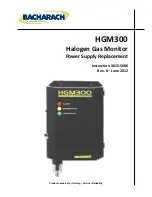
11
Use
en
3
Use
3.1
Prerequisites
Installation should comply with NFPA 72 or any other local and
international regulations and standards, as applicable to flame
detectors and installation of Ex approved products.
To ensure optimal performance and an efficient installation, consider
the following guide lines:
Wiring
The wire gauge must be designed according to the distance
from the flame detector to the controller and the number of
flame detectors on the same power line. For more information
on wire gauges, please refer to the Technical Manual.
To fully comply with EMC directive and protect against
radiofrequency interference (RFI) or electromagnetic
interference (EMI), the cable to the flame detector must be
shielded and the flame detector must be grounded. The shield
should be grounded at the flame detector end.
All cables to the flame detector must be well shielded to
comply with EMC requirements.
Use suitably rated blind plugs for all unused entries.
Ground the flame detector to the nearest ground point (not
more than 3 m (10 ft.) from the detector location).
Install the flame detector with the cable entries placed down-
wards.
Cable gland/conduit Installation
The cable gland/conduit used for the cabling must comply with the
following:
To avoid water condensation in the flame detector, install the
flame detector with the cable gland/conduit (and drain holes)
placed downward.
When using the tilt mount, use flexible cable glands/conduits
for the last portion connecting to the flame detector.
For installations in atmospheres as defined in group B of the
NFPA 72, seal the cable gland/conduit inlets.
When pulling the cables through the cable gland/conduit,
ensure that they are not tangled or stressed. Extend the
cables about 30 cm (12“) beyond the flame detector location
to accommodate wiring after installation.
For conduit installations only:
To reduce the risk of ignition of hazardous atmospheres, the
conduit must be sealed within 45 cm (18") of the enclosure.
Spacing and location
The number of flame detectors and their locations in the protected
area are determined by:
Size of the protected area
Sensitivity of the flame detectors
Obstructed lines of sight
Cone of view of the flame detectors
Environment
Dust, snow, or rain can reduce the flame detector sensitivity
and require more frequent cleaning work.
Dräger Flame 2350/2370:
The presence of high intensity flickering IR sources may affect
sensitivity. In this case, either position or settings of the flame
detector must be adapted.
Summary of Contents for Flame 2100
Page 2: ......
Page 120: ...120 ru 1 1 1 5 135 Dr ger Dr ger Dr ger Dr ger Dr ger 1 2 2 2 1 A 1 2 3 4 5 6 7...
Page 126: ...126 ru 3 3 1 NFPA 72 Ex 3 NFPA 72 30 12 45 18...
Page 127: ...127 ru Dr ger Flame 2350 2370 45 3 2 3 344...
Page 130: ...130 ru A 2 5 15 10 0 3 5 10 15 20 30 0 20 247 BIT 1 BIT BIT BIT 1 BIT 3 BIT 2 YES...
Page 134: ...134 ru 4 0 20 0 Dr ger 4 0 20 0 24 Dr ger 4 0 20 2 BIT Dr ger 0 20 20 Dr ger...
Page 135: ...135 ru 5 5 1 Dr ger 5 2 1 2 3 5 3 1 2 3 3 9 131 3 Dr ger 6 5 2 135 5 3 135 6 1 1 Dr ger Dr ger...
Page 144: ......
Page 145: ......












































